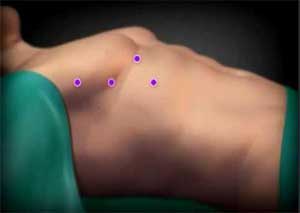- Home
- Editorial
- News
- Practice Guidelines
- Anesthesiology Guidelines
- Cancer Guidelines
- Cardiac Sciences Guidelines
- Critical Care Guidelines
- Dentistry Guidelines
- Dermatology Guidelines
- Diabetes and Endo Guidelines
- Diagnostics Guidelines
- ENT Guidelines
- Featured Practice Guidelines
- Gastroenterology Guidelines
- Geriatrics Guidelines
- Medicine Guidelines
- Nephrology Guidelines
- Neurosciences Guidelines
- Obs and Gynae Guidelines
- Ophthalmology Guidelines
- Orthopaedics Guidelines
- Paediatrics Guidelines
- Psychiatry Guidelines
- Pulmonology Guidelines
- Radiology Guidelines
- Surgery Guidelines
- Urology Guidelines
Keyhole surgery safer,faster than robotic ,conventional mitral valve repair surgery

Keyhole surgery for heart valve repair may trump robotic surgery, because it is associated with lower rates of subsequent heart flutter and blood transfusions, and a shorter hospital stay, reveals research looking at the pros and cons of different surgical approaches, published online in the journal Heart.
But as a keyhole, robotic, and conventional surgery are all very safe and effective, the choice of which to perform should be governed by patient preference and the experience of the operating surgeon, suggest the researchers.
Despite the steep learning curves and additional cost involved, mitral valve repair is the most common heart operation performed using robot-assisted surgery. But to date, few studies have compared it with keyhole and conventional surgical techniques.
The researchers, therefore, drew on a comparison of 2300 patients who needed planned mitral valve repair surgery between 2011 and 2016, and who were allocated to either robotic surgery (372), keyhole surgery (576), or conventional (1352) sternotomy--where the sternum is cut open and divided.
Rates of successful repair were high in those undergoing robotic and keyhole surgery: 91 percent. But they were significantly lower in those who had conventional surgery: 76 percent. This was despite similar rates of degenerative disease across all the cases.
The robotic procedure took the most time to perform--224 minutes compared with 180 minutes for keyhole and 168 minutes for conventional surgery.
The robotic approach had similar outcomes to the conventional approach except that there was half the number of onward discharges to further care--7% vs 15%--and one day less spent in the hospital.
But compared with keyhole surgery, robotic surgery required more blood transfusions (15% vs 5%), was associated with higher rates of heart flutter (atrial fibrillation) of 26% vs 18%, and one day longer in hospital, on average.
Because the cases were all reviewed after surgery had taken place, the findings can’t establish cause, caution the authors, and the patients may not be representative of all those who require mitral valve repair.
There are pros and cons to each of the techniques, prompting the authors to conclude: “From a patient perspective, all three approaches provide excellent outcomes, thus patient preference and surgeon experience should dictate the approach for mitral valve surgery.”
For more reference log on to
http://heart.bmj.com/content/early/2018/05/30/heartjnl-2018-313129

Disclaimer: This site is primarily intended for healthcare professionals. Any content/information on this website does not replace the advice of medical and/or health professionals and should not be construed as medical/diagnostic advice/endorsement or prescription. Use of this site is subject to our terms of use, privacy policy, advertisement policy. © 2020 Minerva Medical Treatment Pvt Ltd